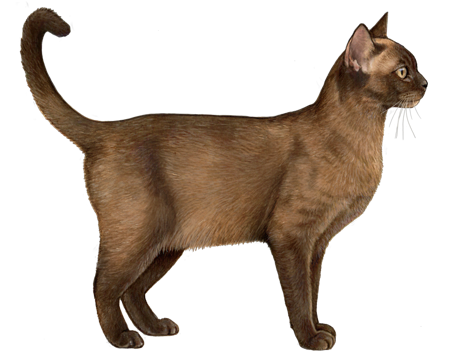
Burmilla
Burmillas are best known for their shimmery silver coats. But these cats also have a charming personality, inquisitive nature, and easygoing attitude—making them irresistible family pets.
Interested in discovering if your cat is a Burmilla?
Check out Wisdom Panel's DNA test.
Burmilla Traits
General Appearance
The Burmilla is a medium-sized cat with an elegant appearance and sparkling silver coat. This breed shares many physical characteristics with the Burmese, but it has a sweeter, more open expression.
Coat and Coloring
Shorthair Burmillas have a silky, smooth-lying coat with enough undercoat to give a slight lift. Longhair Burmillas have semi-long coats, ear tufts, furnishings, and tail plumes. Unlike the shorthairs, they don't have a wooly undercoat.
The Burmilla's coat patterns are chinchilla silver, chinchilla gold, shaded silver, and shaded gold. They come in a variety of colors—including lilac, blue, chocolate, and cream.
Distinctive Physical Traits
Burmilla's have a wedge-shaped head that's wide at the cheekbones and tapers to a blunt muzzle. They have medium-to-large ears with slightly rounded tips, and their large, heavily outlined eyes come in shades of green. Slender legs, neat, oval paws, and a medium-long tail complete their elegant look.
Burmilla Temperament
Burmillas are family-oriented cats with an independent, mischievous nature. They crave attention and can be quite demanding if they feel their humans are stingy with their affection. But they make up for any pushiness with their fun-loving and sweet personalities.
Known for maintaining their kitten-like energy well into adulthood, Burmese make excellent playmates and entertainers. These quiet, gentle cats also get along well with other household pets and kids. But they can take a little time to warm up to visitors.
Burmilla History
Love was in the air in the summer of 1981. That's when a female Lilac Burmese found her way to a male Chinchilla Persian (mere days before his scheduled neutering).
The result of that chance meeting was a litter of shorthaired black shaded silver kittens. The kittens' owner—a British baroness who already bred Persians—found them so attractive that she decided to build a program to develop what became known as the Burmilla.
Burmillas come in both longhair and shorthair varieties. The breed first gained recognition in the U.K. in the 1990s, but it's still very rare today.
Burmilla Care
Nutrition
Burmillas require a high-quality diet. Because nutritional needs vary for kittens, adults, and senior cats, opt for a formula that's age-appropriate for your pet.
To keep your cat at a healthy weight, measure out meals and reduce portions if necessary. And don't forget to account for calories from treats in their daily totals. As a guideline, treats should make up no more than 10% of a cat's calories.
Finally, all cats need access to fresh, clean water around the clock.
Grooming
Burmillas' grooming needs are relatively minimal. Weekly brushing is generally sufficient to remove loose hair and prevent mats or tangles.
Most cats' nails require monthly trimming to prevent them from getting too long. Long nails are more likely to snag on something and become torn or damaged. They can even grow into your cat's paw pads, leading to pain or infection. In addition to clipping, providing a scratching post will allow your cat to do some nail maintenance themselves (thanks to their instinct to scratch).
No grooming routine is complete without a little dental hygiene. To support your Burmilla's overall health, brush their teeth daily and schedule visits with your veterinarian for professional dental cleanings and exams.
Health
Roughly one out of every three cats in the United States is overweight or obese. And those extra pounds can contribute to other health risks—such as arthritis, diabetes, and heart problems. Your veterinarian is the best resource for tips on managing your cat's weight.
Breed Group
Asian
The Asian Group is comprised mainly of genetically similar breeds which vary widely in traits and personalities. These breeds are distinct from those of the Siamese and Oriental Group.
























